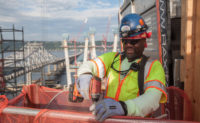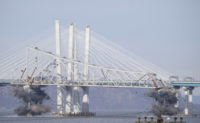Tappan Zee Constructors, the consortium that built the big New York Hudson River crossing that opened in 2018, is embroiled in another lawsuit related to the bridge.
But this one doesn’t concern cost and schedule.
A former staff member who became a safety whistleblower on the project had reached a nearly-complete settlement in December with the Fluor-led consortium. He had claimed that during the project the consortium illegally concealed problems with bolts used in steel connections on the 3.1-mile-long Mario M. Cuomo bridge, named for the former state governor.
The consortium denied it and New York State Thruway Authority claims it has solid engineering evidence that there was no bolt problem and that the structure is safe.
On March 7, the largest newspaper in the New York State capital, the Albany Times Union, published a 7,000-word investigation with many details of the whistleblower's charges.
While the whistleblower settled with the consortium, the allegations remained sealed and secret at the request of the building team.
Now, State Attorney General Letitia James, who joined with the whistleblower as a plaintiff, is pressing to continue the lawsuit and bring some of the documents into public view. The whistleblower has also requested unsealing some documents.
The consortium opposed the unsealing, and offered as a possible alternative, keeping the documents sealed for five more years.
State Supreme Court Judge Joan Lefkowitz, presiding over the case in White Plains, N.Y., ruled that some documents should be opened to the public but the consortium appealed once more.
On March 7, the largest newspaper in the state capital, the Albany Times Union, published a 7,000-word investigation that included many details of the whistleblower charges and claimed the bridge structure itself may be compromised.
Judge Lefkowitz' ruling on the court documents, first reported in the same Times Union story, provides the first public glimpse of the whistleblower's complaint. In it, the whistleblower charged that bolts fractured or broke while being torqued at an off-site assembly site and at the bridge construction site from 2014 to 2016.
With technical information about what occurred still sealed, the newspaper’s report—which included details on metallurgy, quotes from a forensic engineering analysis and a claim that the consortium had agreed to extend its warranty on some portions of the bridge for a year—cannot be fully assessed.
Neither the consortium nor the bridge owner would comment on those details.
In response to the story, however, the thruway authority pointed to its million-dollar engineering analysis, conducted when the charges were first made in 2017, which showed there was no problem with the bolts and that redundancy in the many bolts in the structure assures there is no safety issue.
Jamey Barbas, thruway authority project director, said in a statement that the bridge is safe and the published story is misleading and alarmist.
The wrangle over making documents in the lawsuit public, however, could affect other matters still unfolding in the state and related to the project.
Cited in Push to Oust Cuomo
Tappan Zee Constructors is locked in a legal struggle in the state Court of Claims with the authority over $900 million in costs the consortium says should be paid for its work on the project. The case is just getting under way.
More immediately, the bridge, which replaced the aging Tappan Zee Bridge 15 miles north of New York City, is closely identified with Gov. Andrew Cuomo (D), who had the structure named for his father. Cuomo is now fighting to remain in office after controversies involving pandemic death statistics at nursing homes and separate allegations of sexual harassment.
On March 8, state Senate Majority Leader Andrea Stewart-Cousins added the bridge controversy to her list of reasons for Cuomo to resign. She cited "questions about the construction of a major infrastructure project," referring to the Times Union story, in explaining her position to reporters.
The bridge controversy begins in 2014 with James McNall, who was employed by an administrative subcontractor to the consortium at a worksite at Port of Coeyman's, near Albany, where the consortium and its subcontractors were assembling parts of the bridge frame prior to transporting them down river to the jobsite. McNall said he was offered a safety role on the project, overseeing safety training and the assembly site and other matters.
The state attorney general, Judge Lefkowitz stated, decided to press on as a plaintiff with an unsettled part of the lawsuit.
McNall said he learned of the problem of breaking bolts on steel sub-assemblies from project ironworkers and other staff, according to Judge Lefkowitz’ summary. But McNall said the consortium staff concealed the issue from the thruway authority.
The consortium violated the New York State False Claims Act, McNall charged, by continuing to accept payments for work during the bolt problems and for representing that the bridge complied with design and safety standards.
He said he was fired on July 1, 2016, in retaliation for trying to disclose the alleged bolt problems.
The basic whistleblower lawsuit between McNall and the consortium, Judge Lefkowitz stated in her ruling last month, has been settled out of court, with only McNall’s attorneys' fees and related expenses outstanding. When state attorney general James decided to join as a plaintiff, the consortium asked the judge to continue the document seal, saying it protected the privacy of those involved and headed off possible needless public alarm about the bridge condition.
Fluor and Tappan Zee Constructors did not confirm or deny the settlement with McNall or whether the consortium had appealed Lefkowitz’s Feb. 16 ruling to open some of the court documents.
Adversaries Temporarily United
Although the consortium and authority are contesting the builders' large project claim with full legal arsenals, they are temporarily on the same page over the whistleblower allegations.
Tappan Zee Constructors said in a statement that “the pending court matter discussed in the Times Union’s article remains under court-ordered seal, and we cannot comment on its substance." But it added, “we want to make one thing clear: TZC unequivocally stands by the quality of our work and safety of the bridge.”
Barbas, in her statement, says the thruway authority immediately informed its inspector general of the allegations in 2016 and tested 500 bolts, confirming that they met standards set by the American Society for Testing and Materials.
“The very small number of bolts that were broken is not a cause of safety concern on such a large bridge consisting of more than one million bolts.” she says.
Barbas called the Albany Times Union's reporting reckless.
In an editorial on March 8, the newspaper editorial board doubled down on what was reported, calling on the state to quickly begin a thorough investigation of the bridge.





Post a comment to this article
Report Abusive Comment